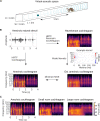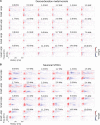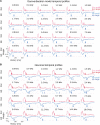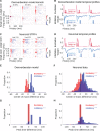Cortical adaptation to sound reverberation
- PMID: 35617119
- PMCID: PMC9213001
- DOI: 10.7554/eLife.75090
Cortical adaptation to sound reverberation
Abstract
In almost every natural environment, sounds are reflected by nearby objects, producing many delayed and distorted copies of the original sound, known as reverberation. Our brains usually cope well with reverberation, allowing us to recognize sound sources regardless of their environments. In contrast, reverberation can cause severe difficulties for speech recognition algorithms and hearing-impaired people. The present study examines how the auditory system copes with reverberation. We trained a linear model to recover a rich set of natural, anechoic sounds from their simulated reverberant counterparts. The model neurons achieved this by extending the inhibitory component of their receptive filters for more reverberant spaces, and did so in a frequency-dependent manner. These predicted effects were observed in the responses of auditory cortical neurons of ferrets in the same simulated reverberant environments. Together, these results suggest that auditory cortical neurons adapt to reverberation by adjusting their filtering properties in a manner consistent with dereverberation.
Keywords: auditory cortex; ferret; neurophysiology; neuroscience; normative model; reverberation.
© 2022, Ivanov et al.
Conflict of interest statement
AI, BW, KW, NH No competing interests declared, AK Senior editor, eLife
Figures















References
-
- Akima H. A Method of Bivariate Interpolation and Smooth Surface Fitting for Irregularly Distributed Data Points. ACM Transactions on Mathematical Software. 1978;4:148–159. doi: 10.1145/355780.355786. - DOI
-
- Allen JB, Berkley DA. Image method for efficiently simulating small‐room acoustics. The Journal of the Acoustical Society of America. 1979;65:943–950. doi: 10.1121/1.382599. - DOI
-
- Alvarez-Morales L, Zamarreño T, Girón S, Galindo M. A methodology for the study of the acoustic environment of Catholic cathedrals: Application to the Cathedral of Malaga. Building and Environment. 2014;72:102–115. doi: 10.1016/j.buildenv.2013.10.015. - DOI
-
- Attias H, Schreiner CE. Temporal Low-Order Statistics of Natural Sounds. In NIPS; 1996.
Publication types
MeSH terms
Associated data
Grants and funding
LinkOut - more resources
Full Text Sources

